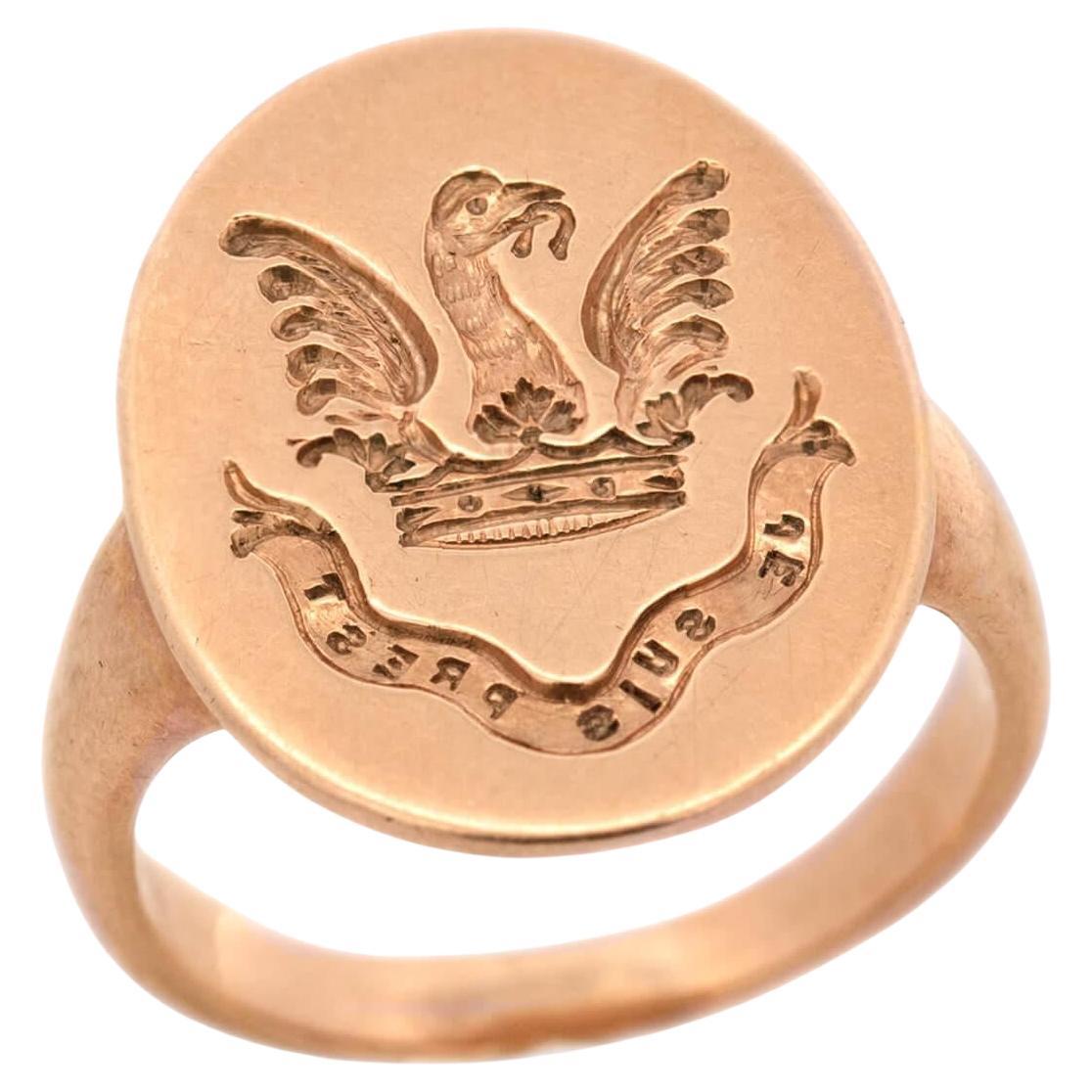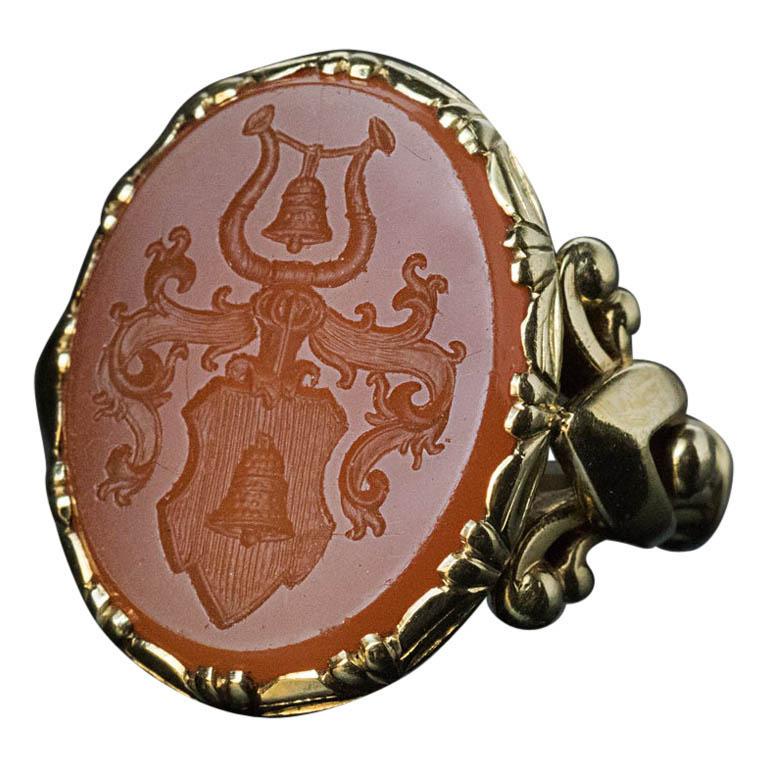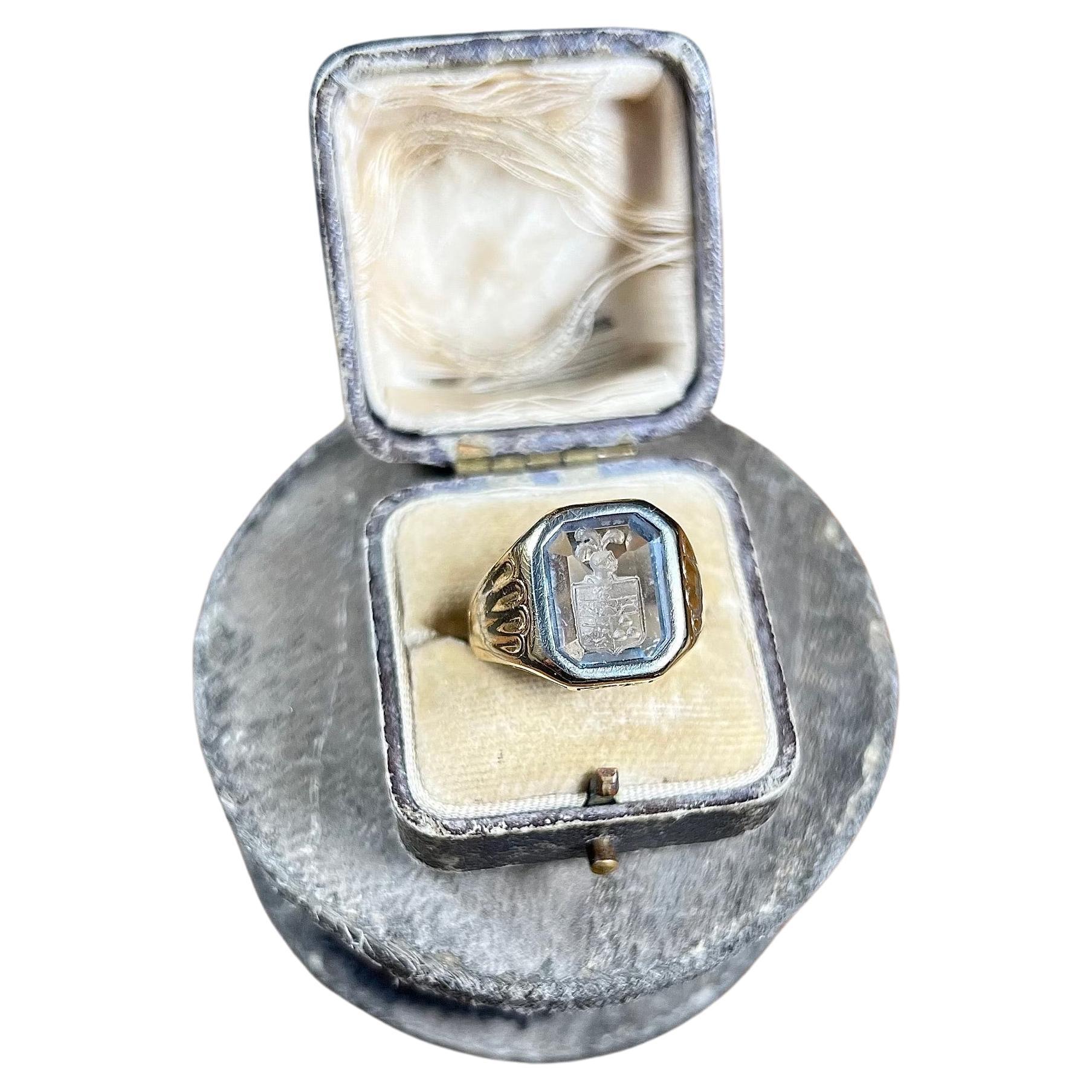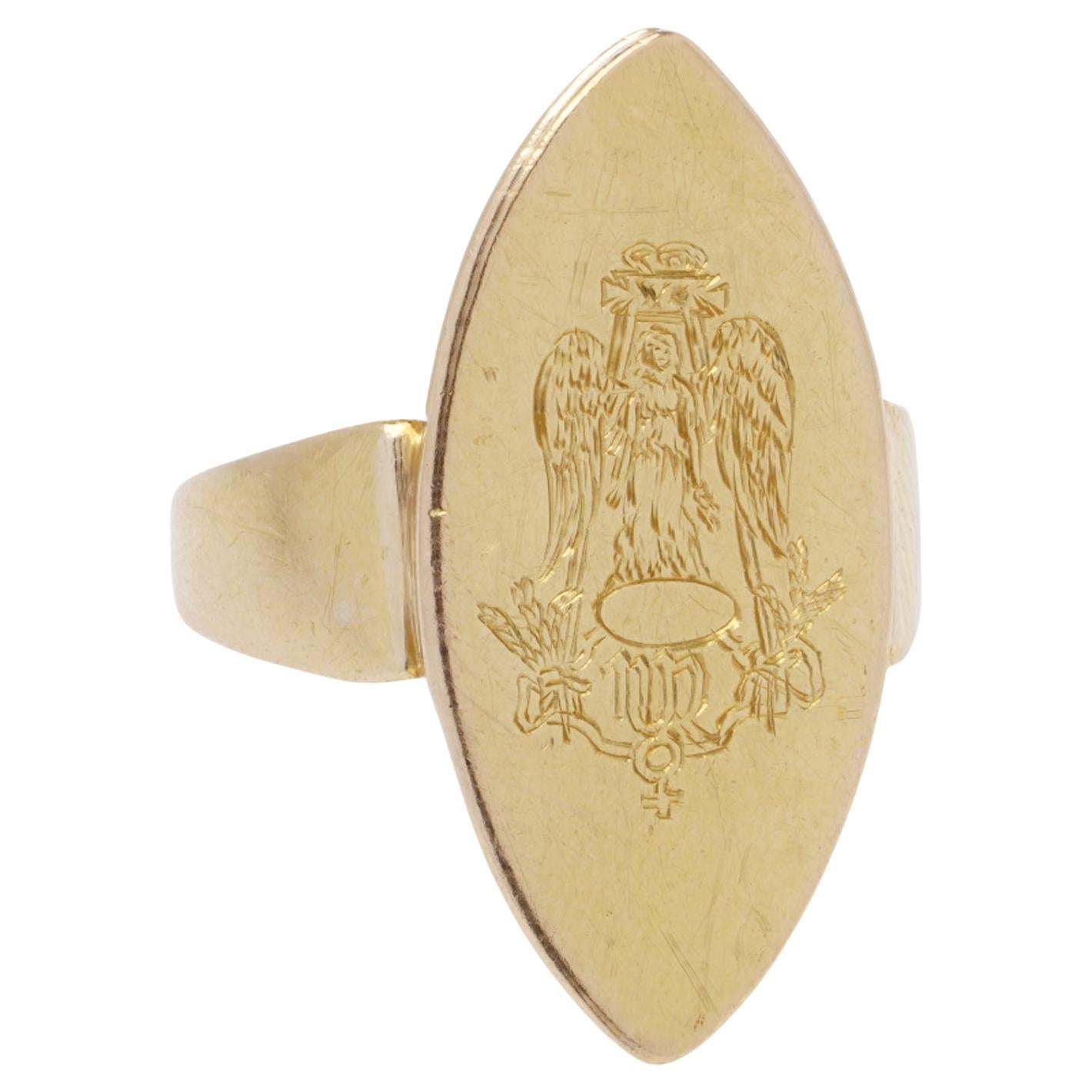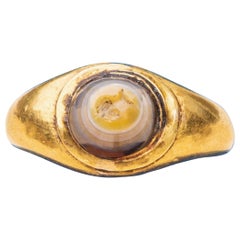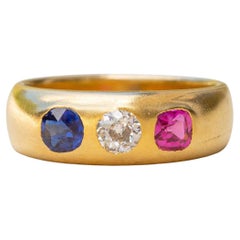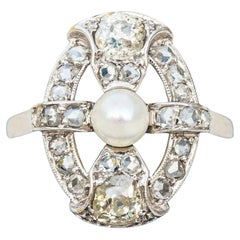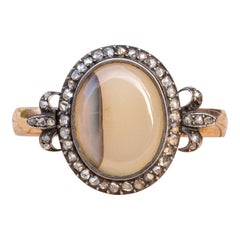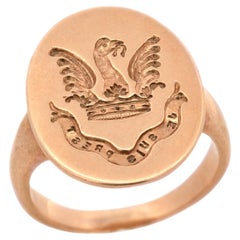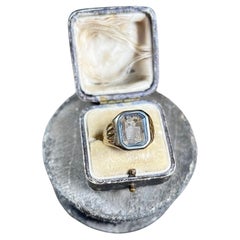Items Similar to French Neo-Renaissance Intaglio Signet Ring Manner of Wièse & Froment-Meurice
Video Loading
Want more images or videos?
Request additional images or videos from the seller
1 of 19
French Neo-Renaissance Intaglio Signet Ring Manner of Wièse & Froment-Meurice
$3,839.23
£2,800
€3,265.58
CA$5,257.22
A$5,845.31
CHF 3,052.10
MX$71,151.70
NOK 38,943.47
SEK 36,488.17
DKK 24,371.63
Shipping
Retrieving quote...The 1stDibs Promise:
Authenticity Guarantee,
Money-Back Guarantee,
24-Hour Cancellation
About the Item
A fantastic French 19th century Neorenaissance silver intaglio ring, in the manner of Jules Wièse and Froment-Meurice, circa 1840. The milky blue chalcedony intaglio is engraved to depict a French heraldic family coat of arms with two roses and a lion. This particular coat of arms is adopted by a number of French noble families, namely the Begon and Joisel families, as well as the Oudan family of Champagne (message for photo for examples).
The bezel set intaglio is surrounded on each side by an intricately worked silver greyhound, a widely used motif in heraldry as well as in the decorative arts to symbolise wealth and the chivalric virtues of faithfulness and loyalty.
UK ring size N , US size 7
7.94g, intaglio measures 11mm x 9mm
A highly skilled chiseller and jeweller from Germany, Jules Wièse (1818-1890) worked in Paris and collaborated closely with the famous goldsmith and jeweller François-Désiré Froment-Meurice (1802-1855) throughout the mid-19th century. In 1855, he directed the execution of the reliquary of the Talisman of Charlemagne for Emperor Napoleon III, and in 1860, the sword of Marshal de Mac-Mahon. The two pioneered the neo-gothic and neo-renaissance styles and made many pieces of jewellery stylistically similar to this ring. A similar example from the Wièse and Froment-Meurice workshop can be found in the British Museum Collection (item AF.2558), message for reference photos.
The ring is stamped on the outside band with an antique French control mark, although it’s somewhat faded, it appears a silver ‘mask’ stamp which indicates that it was made in Paris between 1819-1838 which matches with the style of the ring. The inner band has also been stamped with later English marks from when it would have been brought over and/or sold again locally at a later date, hence the need for an English hallmark to be placed.
- Ring Size:7 US, Not Resizable
- Metal:
- Stone:
- Stone Cut:
- Weight:7.94 g
- Style:
- Place of Origin:
- Period:
- Date of Manufacture:1855
- Condition:
- Seller Location:London, GB
- Reference Number:1stDibs: LU2845218806222
About the Seller
5.0
Vetted Professional Seller
Every seller passes strict standards for authenticity and reliability
Established in 2019
1stDibs seller since 2022
46 sales on 1stDibs
- ShippingRetrieving quote...Shipping from: London, United Kingdom
- Return Policy
Authenticity Guarantee
In the unlikely event there’s an issue with an item’s authenticity, contact us within 1 year for a full refund. DetailsMoney-Back Guarantee
If your item is not as described, is damaged in transit, or does not arrive, contact us within 7 days for a full refund. Details24-Hour Cancellation
You have a 24-hour grace period in which to reconsider your purchase, with no questions asked.Vetted Professional Sellers
Our world-class sellers must adhere to strict standards for service and quality, maintaining the integrity of our listings.Price-Match Guarantee
If you find that a seller listed the same item for a lower price elsewhere, we’ll match it.Trusted Global Delivery
Our best-in-class carrier network provides specialized shipping options worldwide, including custom delivery.More From This Seller
View AllAncient Roman Gold Mens Signet Ring Conical Intaglio Ring Gem Carving
Located in London, GB
A superb ancient Roman agate intaglio ring. The high-karat gold signet ring is set with an engraved gemstone, known as an ‘intaglio’. It dates from between the 2nd to 3rd century AD and is a fine example of a Romano-British intaglio.
The conical-shaped agate gemstone displays various bands of colour ranging from honey brown to greyish-blue. The engraving depicts the bust of a man wearing a helmet, possibly winged which would depict Mercury, the Roman god of commerce, financial gain and communication. In Roman times, people would wear rings with the intaglio of Mercury in hope that the he would protect them and bless them with good financial fortune in their lives.
A number of referenced examples of similar ancient Roman conical shaped intaglios reside in notable museums all across the world, from the British Museum to the Louvre. A page with these examples and their sources can be found in the final photos of the listing. Similar examples can also be found in the extensive Alice and Louis Koch collection (items: 234, 235, 241, 301). Again see final images for reference.
The gold ring mount is of D-shaped cross-section and a hollow 22K gold construction. The ring has a fantastic smooth silk-like texture when worn. It remains in good overall condition and the intaglio is very secure in the mount. The gold mount dates to the late 18th to early 19th century, and the shape is inspired by ancient Roman ring...
Category
Antique 15th Century and Earlier Signet Rings
Materials
Agate, 22k Gold
Antique Austro-Hungarian Gold Ring
Located in London, GB
A stunning antique gold ring, made in Vienna circa 1910. This three-stone gypsy ring is set with a sapphire, an old cut diamond, and a ruby - horizontally aligned in a French flag fo...
Category
Early 20th Century Three-Stone Rings
Materials
Diamond, Ruby, Sapphire, 14k Gold
Antique French Art Deco Diamond Ring Platinum Old Cut Unusual Engagement
Located in London, GB
A superb example of early 20th-century French jewellery, this Art Deco period ring truly embodies the elegance and subtle symbolism of the jewels from this era. Crafted in platinum t...
Category
Vintage 1920s Art Deco Engagement Rings
Materials
Diamond, Cultured Pearl, Platinum
Antique Mid-19th Century, French 18K Agate and Rose Cut Diamond Cluster Ring
Located in London, GB
This stunning antique cluster ring was made in France and dates to around the mid 19th century, circa 1860. In the centre rests a smooth banded agate in an open back setting, encircled by a halo of rose cut diamonds in closed-back, cutdown silver settings with a combined approximate weight of 0.15 carats. The ring has a decorative pierced gallery in the form of crescents and a solid semi-circular shank. The shoulders are decorated with two applied fleur-de-lis, each set with rose cut diamonds in silver settings.
The main colour of the milky agate is a creamy-brown hue with a darker brown band on one side. The diamonds are rose cut, the triangular facets of these cuts were very popular during the Georgian and Victorian periods as they glistened more beautifully in candlelight than any other cut.
This elegant ring sits flat on the finger, the stones are secure in their settings and the ring is in superb condition despite its significant age, a truly rare find!
UK size U / US size 10, 5.44g, French ’tête...
Category
Antique Mid-19th Century French Victorian Cluster Rings
Materials
Agate, Diamond, 18k Gold
Rare Elizabethan 16th Century Gold Cupid Ring Renaissance Gold Ring Womens
Located in London, GB
This exquisite Elizabethan gold ring dates to the mid-16th century (c.1570) and features a circular bezel set with a high-relief cameo of Cupid, delicately carved in white chalcedony...
Category
Antique 16th Century Italian Renaissance Engagement Rings
Materials
Chalcedony, 22k Gold
Small Ancient Roman Medusa Carved Cameo Gold Ring 2nd Century Gem Carving
Located in London, GB
A scarce and small ancient Roman gold Medusa cameo ring, circa 2nd to 3rd century AD.
The carved layered onyx gemstone is white in colour and depicts the bust of Medusa engraved wit...
Category
Antique 15th Century and Earlier Italian Classical Roman Signet Rings
Materials
Onyx, Gold
You May Also Like
French Antique Victorian 15 Kt Signet Ring
Located in Stamford, CT
A French Victorian 15 Kt signet ring that shows all the signs of power. There is an arm raised up showing a dagger. This symbol shows the willingness to prevail. Above the arm is a w...
Category
Antique 1870s French Victorian Signet Rings
Materials
15k Gold
Victorian 14k Intaglio Crest Ring
Located in Narberth, PA
An incredible and unusual gold intaglio crest ring from the Victorian (ca1880) era! This fabulous ring is crafted in vibrant 14k yellow gold and has a large oval-shaped face with a c...
Category
Antique 1880s Victorian Signet Rings
Materials
Gold, 14k Gold, Yellow Gold
Antique Late 19th Century Armorial Signet Ring
Located in Chicago, IL
Circa 1880s
This antique 14K yellow gold signet ring from the Victorian era features a carnelian intaglio intricately engraved with a bel...
Category
Antique Late 19th Century Victorian Signet Rings
Materials
Carnelian, 14k Gold
Antique 9ct Two Gold Edwardian Carved Glass Seal Signet Ring
Located in Brighton, GB
Antique Seal Ring
9ct Gold Tested
Circa 1910
Lovely, large Edwardian signet ring. Set with a light blue, carved glass, family crest. Framed in ...
Category
Early 20th Century English Edwardian Signet Rings
Materials
Gold, 9k Gold
Victorian 22K Gold Signet Ring, 1896
Located in Braintree, GB
A substantial Victorian signet ring crafted in 22K yellow gold. The ring features an elongated, navette-shaped face engraved with a heraldic crest, possibly representing nobility or ...
Category
Antique 1890s British Victorian Signet Rings
Materials
22k Gold
Victorian 10K Gold Austro-Hungarian Men’s Signet Ring
Located in Venice, CA
Recently sourced on a trip to Prague, this crown-shaped signet ring is a perfect men’s ring circa the Victorian era. The borders of the shield-shaped signet are made up of scrolling ...
Category
Antique 19th Century Unknown Victorian Signet Rings
Materials
Gold, 10k Gold
More Ways To Browse
Signet Ring Coat Arms
Intaglio Jewelry Blue
Antique French Signet Ring
Antique Silver Signet Ring
Renaissance Intaglio
Intaglio Lion
Chalcedony Intaglio
English Signet Ring
Blue Intaglio Ring
Wiese Jules
Froment Meurice
Lion Signet Ring Antique
Greyhound Ring
Champagne Sword
Greyhound Intaglio
Signet Ring Coat Arms
Old Mine Diamond Mens Ring
Turquoise Men Rings

